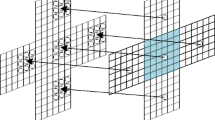Abstract
The proposed paper discusses two switching error concealment algorithms: SECA (Switching Error Concealment Algorithm) and OSECA (Optimal Switching Error Concealment Algorithm) to efficiently switch among three existing error concealment methods for optimal performance and complexity tradeoff. SECA uses the motion vector statistics in the neighborhood of the lost MB (Macro Block) to make the switching decision. SECA is better than the best-PSNR method by 0.14 dB in PSNR and better than the best-win-rate method by 1.49 % in win rate, with 63 % time complexity reduction. OSECA further considers the correlation between surrounding pixels of the lost MB and the pixels in the reference frame. An optimization problem is formulated to derive the optimal decision thresholds. For OSECA, the PSNR performance is further improved by 0.24 dB from SECA and the time complexity reduction from the existing work can increase to 69 %. On different testing sets of the lost MBs, the proposed SECA and OSECA perform consistently against existing methods. Compared to SECA in the testing sets, OSECA has larger PSNR improvement (by up to 0.23 dB) against the best-PSNR method, and has larger time complexity reduction (by up to 71 %) against existing method.













Similar content being viewed by others
References
Chen X, Chung YY, Bae C, He X, Yeh W-C (2010) An efficient error concealment algorithm for H.264/AVC using regression modeling-based prediction. IEEE Trans Consum Electron 56(4):2694–2701
Chen Y, Hu Y, Au OC, Li H, Chen CW (2008) Video error concealment using spatio-temporal boundary matching and partial differential equation. IEEE Trans Multimedia 10(1):2–15
Chen W-C, Lin T-L, Lee H-C (2013) Efficient and adaptive switching error concealment method using neighboring motion vector statistics. IEEE Int Symp Consum Electron 47–48
Chen C, Liu Y, Yang Z, Bu J, Deng X (2008) Multi-frame error concealment for H.264/AVC frames with complexity adaptation. IEEE Trans Consum Electron 54(3):1422–1429
Chien J-T, Li G-L, Chen M-J (2010) Effective error concealment algorithm of whole frame loss for H.264 video coding standard by recursive motion vector refinement. IEEE Trans Consum Electron 56(3):1689–1695
Hsia SC (2004) An edge-oriented spatial interpolation for consecutive block error concealment. IEEE Signal Process Lett 11(6):577–580
Kim M, Lee H, Sull S (2008) Spatial error concealment for H.264 using sequential directional interpolation. IEEE Trans Consum Electron 54(4):1811–1818
Peng Q, Yang T, Zhu C (2002) Block-based temporal error concealment for video packet using motion vector extrapolation. IEEE Int Conf Commun Circuits Syst West Sino Exp 1:10–14
Persson D, Eriksson T (2009) Mixture model- and least squares-based packet video error concealment. IEEE Trans Image Process 18(5):1048–1054
Persson D, Eriksson T, Hedelin P (2008) Packet video error concealment with gaussian mixture models. IEEE Trans Image Process 17(2):145–154
Qian X, Liu G, Wang H (2009) Recovering connected error region based on adaptive error concealment order determination. IEEE Trans Multimedia 11(4):683–695
Seth K, Kamakoti V, Srinivasan S (2010) Efficient motion vector recovery algorithm for H.264 using B-Spline approximation. IEEE Trans Broadcast 56(4):467–480
Tröger T, Kaup A (2011) Inter-sequence error concealment techniques for multi-broadcast TV reception. IEEE Trans Broadcast 57(4):777–793
Valente TS, Dufour C, Groliere F, Snook D (2001) An efficient error concealment implementation for MPEG4 video streams. IEEE Trans Consum Electron 47(3):568–578
Wang Y-K, Hannuksela MM, Varsa V, Hourunranta A, Gabbouj M (2002) The error concealment feature in the H.26L test model. IEEE Int Conf Image Process 2:729–732
Xu Y, Zhou Y (2008) Adaptive temporal error concealment scheme for H.264/AVC video decoder. IEEE Trans Consum Electron 54(4):1846–1851
Yan B, Gharavi H (2010) A hybrid frame concealment algorithm for H.264/AVC. IEEE Trans Image Process 19(1):98–107
Zhang J, Arnold JF, Frater MR (2000) A cell-loss concealment technique for MPEG-2 coded video. IEEE Trans Circuits Syst Video Technol 10(4):659–665
Zhang Y, Xiang X, Zhao D, Ma S, Gao W (2012) Packet video error concealment with auto regressive model. IEEE Trans Circuits Syst Video Technol 22(1):12–27
Zheng J, Chau LP (2005) Efficient motion vector recovery algorithm for H.264 based on a polynomial model. IEEE Trans Multimedia 7(3):507–513
Zhou J, Yan B, Gharavi H (2011) Efficient motion vector interpolation for error concealment of H.264/AVC. IEEE Trans Broadcast 57(1):75–80
Acknowledgments
The authors would like to thank the anonymous reviewers of their paper for the many helpful suggestions. This research is supported by the National Science Council, Taiwan under Grant NSC 100-2218-E-033-004, NSC 101-2221-E-033-036, NSC 102-2221-E-033-018, and by the Ministry of Science and Technology, Taiwan under Grant MOST 103-2221-E-033-020, MOST 103-2221-E-033-070 and MOST-103-2221-E-034-010.
Author information
Authors and Affiliations
Corresponding author
Rights and permissions
About this article
Cite this article
Lin, TL., Chen, WC., Fan, CY. et al. Switching error concealment algorithm based on optimal decisions for performance and complexity. Multimed Tools Appl 75, 11199–11219 (2016). https://doi.org/10.1007/s11042-015-2841-9
Received:
Revised:
Accepted:
Published:
Issue Date:
DOI: https://doi.org/10.1007/s11042-015-2841-9




